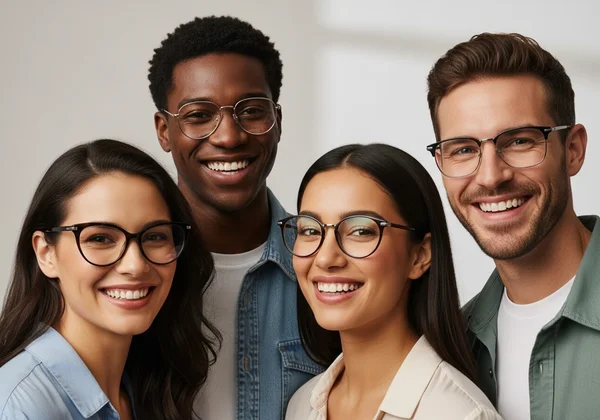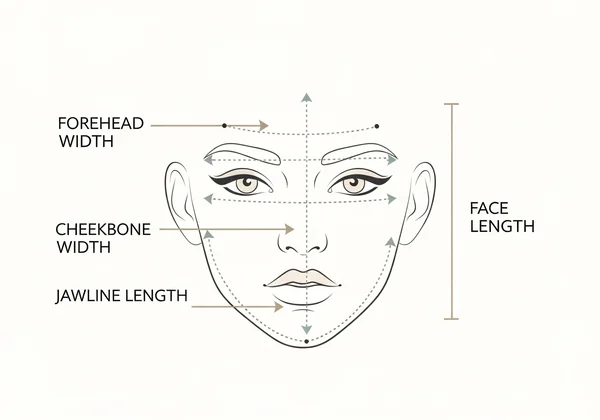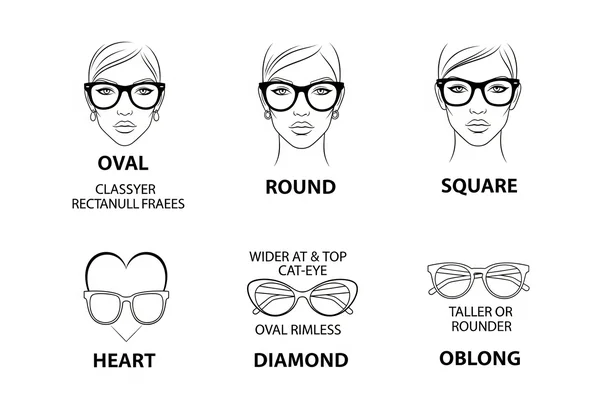Glasses for Face Shapes: A Guide on How to Determine Your Face Shape
Feeling overwhelmed by endless rows of eyeglasses? Choosing the wrong pair can throw off your look, while the right one enhances your best features. The secret isn't just about style—it's about science. This guide will teach you the simple principles of matching frames to your unique glasses for your face shape, turning a frustrating search into a confident decision. So, how to determine face shape for the perfect fit? The first step is knowing your own facial geometry, and from there, the process becomes simple and even fun.
Think of this guide as your personal stylist. We'll give you all the insider tips to pick glasses that highlight your best features. We will break down the foundational principles of balance and contrast, explore the ideal frame styles for six common face shapes, and provide extra tips to ensure your next pair of glasses is your best yet. Before you start shopping, get an accurate result with our free AI face shape detector.

First, How to Determine Your Face Shape
Before you can find the perfect glasses, you need a crucial piece of data: your face shape. Knowing whether your face is oval, square, round, or another shape is the foundation for making an informed choice. There are two primary ways to figure this out, one powered by technology and the other by a simple measuring tape.
The Simple Way: Use Our AI Face Shape Detector
For a quick, accurate, and objective answer, the easiest method is to use a dedicated tool. Traditional methods like looking in the mirror can be subjective and confusing. Our AI Face Shape Detector is designed to eliminate the guesswork. The process is straightforward: upload a clear, front-facing photo, and our technology instantly analyzes your facial contours, proportions, and key features.
Within seconds, you'll receive a precise result. This method is not only fast and free but also completely private—we never store your images. Getting an objective analysis is the most reliable first step to building your style confidence. Ready to know for sure? Get an instant result with our AI tool.
The Manual Method: Measuring Your Face at Home
If you prefer a hands-on approach, you can measure your face yourself. This method requires a flexible measuring tape and a moment to jot down some numbers. While it can be less precise than an AI analysis, it provides a good general idea of your facial proportions.
- Forehead Width: Measure the distance across your forehead at the widest point, typically midway between your eyebrows and hairline.
- Cheekbone Width: Find the widest point across your cheekbones, usually just below the outer corners of your eyes, and measure from one side to the other.
- Jawline Length: Measure from the tip of your chin to the point below your ear where your jaw angles upward. Multiply that number by two to get your combined jawline length.
- Face Length: Measure from the center of your hairline straight down to the tip of your chin.
Compare these measurements to identify your shape. For example, if all measurements are fairly similar and you have a soft jawline, you likely have a round face. If your face length is the largest measurement, you might have an oblong face.

The Core Principle: A Guide to Contrast and Balance
The fundamental rule for choosing flattering eyeglasses is simple: create contrast between your face shape and your frame shape. The goal is to select frames that balance your proportions, not mimic them. This principle of opposition is what creates aesthetic harmony and enhances your best features.
Why Angular Frames Complement Round Faces
If you have a round face shape, characterized by soft curves and similar width and length, your goal is to add definition and structure. Sharp, angular frames like square or rectangular styles break up the roundness of your face. They create the illusion of length and definition, drawing attention to your eyes and making your face appear slimmer and longer. Choosing a round frame for a round face would only accentuate its roundness.
Why Softer Frames Soften Angular Faces
Conversely, if you have an angular face shape, such as a square or diamond face with a strong jawline or prominent cheekbones, your goal is to soften those features. Frames with soft curves, like round or oval shapes, provide a gentle contrast to sharp lines. They balance a strong jaw and prevent your overall look from appearing too severe, adding a touch of softness where it's most effective.

An Eyeglasses Face Shape Guide for Men and Women
Now that you understand the core principle and have a way to identify your face shape, let’s dive into specific recommendations. Here is a detailed guide to the best frame styles for the six most common face shapes.

Best Glasses for an Oval Face Shape
Often considered the "universal" face shape due to its balanced proportions, an oval face is longer than it is wide, with a softly curved jawline. If you have an oval face, you're in luck—a wide variety of frame styles will suit you. The key is to maintain your natural balance.
- Recommended Frames: Look for frames that are as wide as or slightly wider than the broadest part of your face. Square, rectangular, and geometric shapes add some angles to your soft curves. Walnut-shaped frames that are not too deep or narrow also work exceptionally well.
- What to Avoid: Try to steer clear of oversized frames that can disrupt your natural symmetry.
Flattering Glasses for a Round Face Shape
A round face shape has similar width and length, with soft curves, full cheeks, and a rounded chin. The goal is to make the face appear longer and thinner. You can achieve this by choosing frames that add sharp lines and definition.
- Recommended Frames: Angular and geometric frames are your best friends. Go for bold square or rectangular styles to create contrast. Frames that are wider than they are tall will also help slim the face.
- What to Avoid: Avoid small, round, or oversized frames, as they will emphasize the roundness of your face. Knowing your exact face shape is the key, and our AI face shape analyzer can give you a quick result.
Top Eyeglasses for a Square Face Shape
A square face is characterized by a broad forehead, wide cheekbones, and a strong, angular jawline. The face's width and length are roughly equal. If you have a square face, the trick is to soften those amazing angles with frames that add a touch of gentle curve.
- Recommended Frames: Round and oval frames are excellent choices as their soft curves provide a beautiful contrast to your angular features. Thinner frames can also prevent your look from feeling too heavy.
- What to Avoid: Steer clear of boxy, square, or geometric frames that will only highlight the angularity of your face. Our free AI face shape analysis can confirm your type in seconds.
Ideal Frames for a Heart Face Shape
A heart-shaped face is widest at the forehead, gradually narrows through the cheekbones, and ends at a slender chin. This shape is also sometimes called an inverted triangle. The goal is to add width to the lower part of your face to create a more balanced silhouette.
- Recommended Frames: Look for frames that are wider at the bottom than the top. Bottom-heavy styles, rimless frames, and light-colored or thin frames are all great options. Aviators and frames with low-set temples can also work wonders.
- What to Avoid: Avoid any styles that are heavier or wider on top, such as decorative top-heavy frames or extreme cat-eye shapes.
Perfect Glasses for a Diamond Face Shape
Diamond faces are narrowest at the forehead and jawline, with broad, high cheekbones as the widest point. This is one of the rarer face shapes. The goal is to soften the cheekbones and draw attention to the eyes.
- Recommended Frames: Frames that sweep upward or are wider than the cheekbones will accentuate your eyes. Cat-eye and oval frames are fantastic choices. Rimless or semi-rimless styles can also be very flattering as they keep the look open and light. You can use our free face shape tool to see if you have this unique shape.
- What to Avoid: Avoid narrow or boxy frames, as they can make your cheekbones appear wider and your eye line narrower.
Recommended Glasses for an Oblong Face Shape
An oblong, or rectangular, face is longer than it is wide and has a long, straight cheek line. The goal is to make the face appear shorter and more proportional.
- Recommended Frames: Choose frames that have more depth than width. Tall, square frames or styles with decorative temples can add width to your face. A low bridge can also help shorten the appearance of your nose.
- What to Avoid: Avoid narrow, rectangular frames that will only make your face appear longer.
Beyond Shape: Choosing Frame Size and Color
Finding the right shape is the most important step, but perfecting your look involves a few more details. Frame size and color play a significant role in how your new glasses will feel and look.
How to Ensure Your Glasses Are the Right Size
Proportion is key. Your frames should be in scale with the rest of your face. They shouldn't be wider than the width of your face at the temples. The top of your frames should generally follow the line of your eyebrows, and your eyes should be centered within the lenses. When you smile, your cheeks shouldn't push the frames up.
Matching Frame Color to Your Skin Tone
Just like with clothing, certain colors will be more flattering than others. Understanding this relationship is a key part of color theory in fashion, and it starts with your skin's undertone. Skin tones are generally categorized as "cool" (blue or pink undertones) or "warm" (yellow or golden undertones).
- Cool Tones: If you have a cool complexion, look for frames in colors like black, silver, gray, blue, purple, and jewel tones.
- Warm Tones: For warm complexions, frames in gold, brown, beige, olive green, and honey-yellow are excellent choices.
Choosing the perfect pair of glasses doesn't have to be a game of chance. By understanding your face shape and applying the principle of contrast, you can strategically narrow down your options and select frames that truly enhance your appearance. The first and most important step is getting an accurate read on your facial structure.
Ready to stop guessing? Find out your face shape for sure. Use the AI face shape detector to get a quick, precise, and private analysis. Armed with that knowledge, you can use this guide to walk into any optical store or browse online with the confidence of an expert. Make your next eyewear purchase a decision you’ll love for years to come.
Your Eyeglasses Questions Answered
What is my face shape for glasses?
The best way to determine your face shape for glasses is to use a reliable method. You can measure your forehead, cheekbones, jawline, and face length to compare proportions. However, for a fast, free, and highly accurate answer, we recommend using our AI-powered tool. The free face shape detector analyzes your photo instantly without storing it, giving you the perfect starting point for your search.
What face shape looks good with aviator glasses?
Aviator glasses are a classic style that works particularly well for several face shapes. Their top-heavy design and curved bottoms are ideal for heart face shapes, as they balance a wider forehead and a narrower chin. They also look great on oval and square faces, as their softer curves can help soften angular jawlines.
Should my eyebrows show when wearing glasses?
Ideally, yes. The top rim of your glasses should follow the natural curve of your eyebrows, sitting just below them. Your eyebrows are a key part of your facial expressions, and hiding them completely can obscure your emotions. Having a small amount of space between the top of the frame and your brow line is generally the most flattering look.